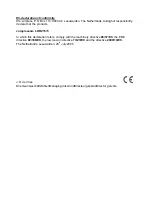
9
7. OPERATION PROCEDURES
Daily start-up Procedures
1. Set the Auto-On/Off lever to the Off position.
2. Check the air compressor visually for any damage or obstruction.
3. Close the drain valve.
4. Check the oil level of the pump.
5. Attach the air hose to the quick coupler by pulling back on the outer sleeve of
the quick. Release the outer sleeve and make sure the hose stays in place.
6. Plug the power cord into the proper receptacle.
7. Install the desired air accessory to the open end of the air hose before
proceeding any further. Failure to do so will not allow any pressure to build
up in the hose.
8. Turn the Auto-on/Off lever to the On-Auto position and the compressor will
start and build air pressure in the tank to cut-out pressure and then shut off
automatically.
9. Adjust the regulator to a bar/PSI setting that is needed for your application
and be sure it is within the safety standards required to perform the task. If
using a pneumatic tool; the manufacturer should have recommendations in
the manual for the particular tool on operating PSI settings.
Daily Shut-Down Procedures
1. Unplug the power cord from the receptacle.
2. Set the outlet pressure to zero on the regulator.
3. Remove any air tools or accessories. When draining the tank, always use
ear and eye protection. Drain the tank in a suitable location; condensation
will be present in most cases of draining.
4. Open the drain valve allowing air to bleed from the tank. After all of the air
has bled from the tank, close the drain valve to prevent debris buildup in the
valve.
CAUTION
When draining the tank, always use ear and eye protection. Drain the tank in a
suitable location; condensation will be present in most cases of draining.
WARNING
Water that remains in the tank during storage will corrode and weaken the air
tank, which could cause the tank to rupture. To avoid serious injury, be sure to
drain the tank after each use or daily.
8. MAINTENANCE
NOTE: Qualified service personnel should perform any service procedure not
covered in the maintenance schedule below.
ITEMS TO CHECK/CHANGE
Before each
use or daily
After first
ten hours
Every 100
hours





































